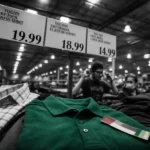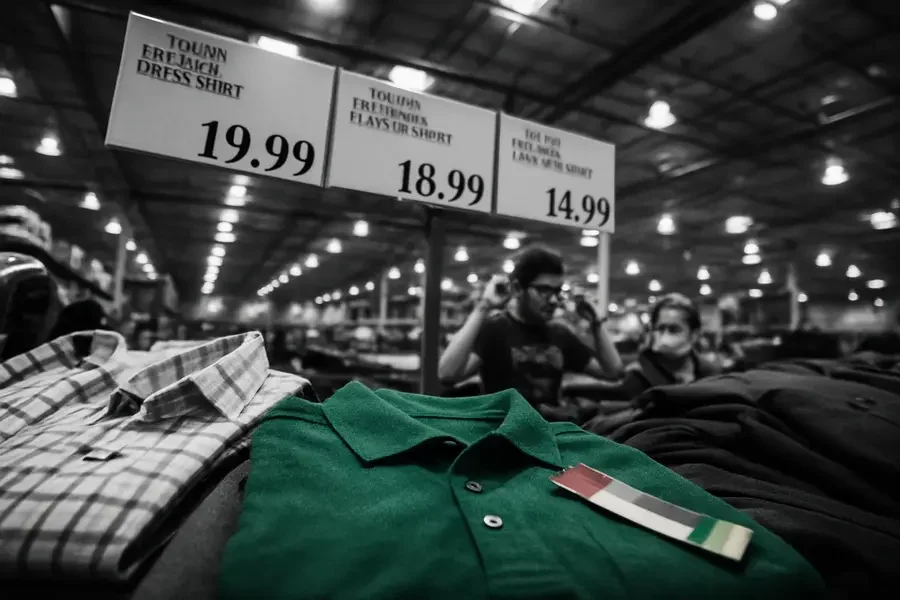ISSAQUAH, October 10, 2025 – Costco Wholesale Corp (COST.O) has grown its clothing business by nearly 40% over the past five years, significantly outperforming warehouse competitors BJ’s Wholesale Club and Sam’s Club 1. The retailer’s apparel segment now generates approximately 9 billion annually, positioning it as a major force in the clothing retail landscape 8.
- Costco clothing sales grew 40% in five years
- Annual apparel revenue reaches 9 billion
- Outperforms Old Navy, Neiman Marcus in sales
Market Position and Scale
Costco’s clothing business now surpasses traditional fashion retailers including Old Navy, Neiman Marcus, and Ralph Lauren in annual sales volume 2. The warehouse giant’s apparel revenue has evolved from a supplementary category to a substantial profit driver, contributing meaningfully to the company’s overall financial performance.
The growth trajectory significantly exceeds that of direct competitors BJ’s Wholesale Club (BJ.N) and Sam’s Club, owned by Walmart Inc (WMT.N), highlighting Costco’s competitive advantage in the membership-based retail model 1.
Strategic Approach and Pricing
Costco’s success stems from its high-volume, low-margin strategy featuring aggressive price points across clothing categories. The retailer offers jeans for 14, dress shirts for 25, and premium items around 100, creating compelling value propositions for budget-conscious consumers 8.
The company’s private-label Kirkland Signature brand plays a crucial role in the clothing strategy, contributing to both margin expansion and customer loyalty. Kirkland has evolved beyond a simple store brand into what industry observers describe as Costco’s “secret weapon” and a billion-dollar empire in its own right 3.
Operational Excellence
Costco’s clothing success reflects broader operational strengths including supply chain efficiency and inventory management. The company’s approach of carrying limited SKUs in large quantities allows for better supplier negotiations and cost control, translating into competitive retail prices.
The retailer’s membership model creates a captive customer base with higher average spending patterns compared to traditional retail formats. This membership revenue stream also supports the company’s ability to maintain lower margins on merchandise while preserving profitability.
Industry Impact and Outlook
The warehouse retailer’s emergence as a clothing powerhouse demonstrates the ongoing disruption in traditional retail channels. Costco’s success challenges conventional wisdom about where consumers prefer to purchase apparel, particularly as value consciousness remains elevated among shoppers.
Industry analysts view Costco’s clothing growth as sustainable given the company’s operational advantages and membership loyalty. The business model’s resilience during economic uncertainty provides additional confidence in the segment’s long-term prospects.
Not investment advice. For informational purposes only.
References
1CNBC (2025). “How Costco quietly built a multibillion-dollar clothing empire”. CNBC. Retrieved October 10, 2025.
2Fast Company (2019). “How Costco quietly became a 7-billion fast-fashion powerhouse”. Fast Company. Retrieved October 10, 2025.
3YouTube (2024). “Costco’s Secret Weapon: How Kirkland Became a Billion-Dollar Brand”. YouTube. Retrieved October 10, 2025.
4Acquired Podcast (2023). “Costco: The Complete History and Strategy”. Acquired. Retrieved October 10, 2025.
5Washington Post (2019). “Costco quietly becomes a destination for clothes”. Washington Post. Retrieved October 10, 2025.
6YouTube (2025). “Inside Costco: The Shocking Strategy That Built The Most Loyal”. YouTube. Retrieved October 10, 2025.
7CMoney (2025). “How Costco quietly built a multibillion-dollar clothing empire”. CMoney. Retrieved October 10, 2025.
8SatPost by Trung Phan (2023). “Costco’s 9B clothes business, explained”. SatPost. Retrieved October 10, 2025.
9CNBC (2025). “The Partner with Marcus Lemonis – Watch Latest Clips”. CNBC. Retrieved October 10, 2025.

